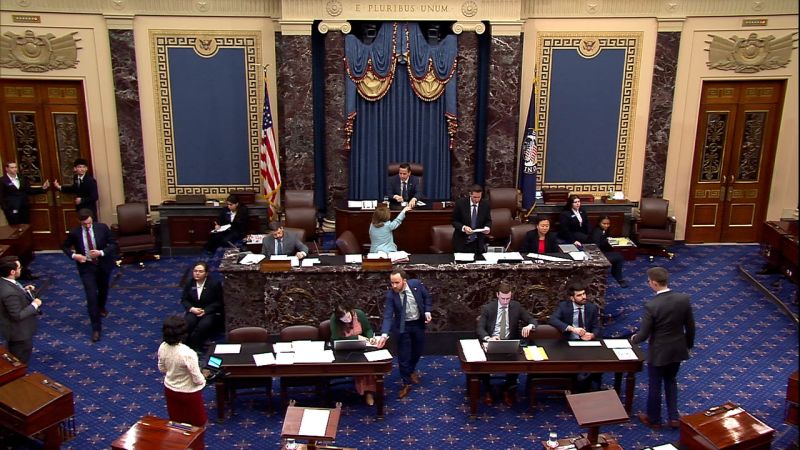In a significant political maneuver, Vice President JD Vance made his way to Capitol Hill late on a Wednesday evening to cast a tie-breaking vote in the Senate, effectively quashing a bipartisan initiative aimed at counteracting President Donald Trump’s controversial trade policies. This event marks a critical moment in the ongoing debate surrounding tariffs and trade relations, highlighting the tension between the executive branch and Congress over economic policy decisions.
Earlier that night, the Senate voted on a resolution intended to block Trump’s global tariffs by cancelling the emergency order that the President has leveraged to impose them. However, the resolution failed to gain sufficient support, resulting in a 49-49 deadlock. Notably absent from the vote were two key senators: Republican Mitch McConnell and Democrat Sheldon Whitehouse. Their absence was crucial and allowed the resolution to face defeat without the necessary majority to proceed.
After the resolution’s failure, Senate Majority Leader John Thune took steps to prevent tariff opponents from resurrecting their proposal in the future. This decision necessitated Vice President Vance’s immediate presence at the Capitol to cast the tie-breaking vote, which is a rarity. In fact, this situation marked only the second occasion during his tenure as Vice President that he was called upon to utilize his authority in this capacity.
During Trump’s second term, he has enacted historic tariffs across a diverse range of imports, which has become a hallmark of his economic policy. These tariffs include a sweeping 10% charge on nearly all imports entering the United States, as well as more substantial tariffs of 25% on steel, aluminum, and automobiles, particularly impacting products from Canada and Mexico. Furthermore, many Chinese goods have been levied with tariffs soaring to at least 145%, representing one of the most aggressive trade actions seen in recent history.
Democratic Senator Tim Kaine, a co-sponsor of the resolution designed to challenge these tariffs, suggested that Vance’s necessity to break the tie could, in fact, work in favor of those advocating for the resolution. Kaine articulated that showcasing the Vice President’s involvement would help inform the American public of the responsibilities and consequences tied to these tariffs. “They are so dead set on this tariff idiocy that are wrecking the economy that they’re going to bring the Vice President over to completely own it,” he remarked, emphasizing that the implications of these policies should be clear to voters.
Senate Minority Leader Chuck Schumer joined in the criticism, accusing Republican lawmakers, particularly Thune, of taking deliberate steps to uphold Trump’s tariffs. He asserted that such actions would only further the interests of the President’s controversial trade agenda.
Despite some Republican collaboration on the resolution—namely from Senators Rand Paul, Susan Collins, and Lisa Murkowski—the absence of McConnell and the resultant bottom line of 49-49 left them unable to secure a winning vote. Reports indicate that McConnell, although he missed the vote due to health reasons, had previously signaled opposition to the tariffs. His spokesperson reiterated that McConnell views tariffs as an unwarranted tax imposed on American families and businesses, arguing that engaging in trade wars ultimately harms the economy.
Even if the resolution had passed the Senate, its prospects in the House were grim from the start. House Speaker Mike Johnson had previously enacted procedural measures to delay consideration of such resolutions until a far-distant date, effectively stifling any opposing efforts from gaining traction.
Earlier in the month, the Senate attempted a symbolic gesture aimed at denouncing Trump’s tariffs on Canada, only for House Republicans to stifle the resolution’s progress using the same procedural techniques designed to limit discussion in their chamber. Meanwhile, Trump, undeterred by the pushback from Congress and public criticism, has maintained an assertive stance on his tariff program, vowing to utilize his veto power if necessary to protect his economic agenda.
This unfolding story encapsulates a significant moment within the socio-political landscape, revealing ideological divides, partisan strategies, and ongoing debates surrounding trade and economic policy. As more developments arise, it is clear that the discourse surrounding tariffs will continue to be a focal point of political contention in the current landscape.
Adding to the complexity, CNN’s Dave Goldman contributed to the report, ensuring the narrative remained updated and reflective of the latest happenings surrounding this pivotal issue.



